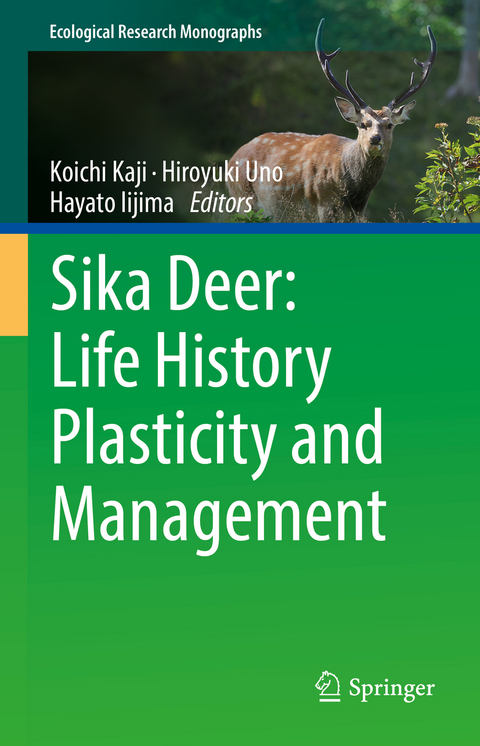
Sika Deer: Life History Plasticity and Management
Springer Verlag, Singapore
978-981-16-9553-7 (ISBN)
This book provides complete and up-to-date information on sika deer biology and its management, focusing on their life history with an integrated approach of population dynamics, morphology, genetics, and evolution.
The expanding distribution of sika and its increase in population in Japan and other countries are causing damage to agriculture and forestry, impacting ecosystems and affecting other species. We are facing conflicting deer issues regarding the conservation of resource values and pest control of sika deer.
This contributed volume compiles new findings focusing on the ecological plasticity of the sika deer. It aims to clarify the ecological characteristics of the deer by integrating studies of different approaches and provides a perspective for their management.
The book consists of six parts. Part I introduces the ecological and management background behind the history of sika deer. The following four parts discuss movement ecology (Part II), impact on vegetation and bottom-up effect on sika deer (Part III), impact on ecosystem and its resilience (Part IV), and comparison of life-history characteristics between sika deer and other ungulate species (Part V). The last part (Part VI) covers the science-based management of sika deer.
Contributed by recognized experts and young researchers of sika deer, this book appeals to researchers and professionals in wildlife biology and wildlife management, evolution, population dynamics, morphology, genetics, and reproductive physiology.
Koichi Kaji, Ph.D., Emeritus professor of Tokyo University of Agriculture and Technology/Director of Wildlife Management Research Center, Hyogo Hiroyuki Uno, Ph.D., Professor of Tokyo University of Agriculture and Technology Hayato Iijima, Ph.D., Senior Researcher of Department of Wildlife Biology, Forestry, Forest Products Research Institute
1.Introduction.- 2. The Process of Population Expansion of Sika Deer.- 3. The Impact of Sika Deer on Vegetation in Japan.- 4.Estimation of Sika Deer Abundance by Harvest-based Model and the Characteristics of their Population Dynamics.- 5. Variation in the local sika deer density between three areas of Japan with diverse climatic conditions.- 6. Ecological and evolutionary response of sika deer morphology to varying habitat environments: from body size to tooth wear.- 7. Reproductive variation of sika deer.- 8. Movement Patterns of Sika Deer in Hokkaido Region.- 9. Movement Patterns of Sika Deer in Tohoku Region.- 10. Movement patterns of sika deer in the mountainous regions of central Honshu.- 11. Movement Characteristics and Habitat Use of Sika Deer in Kanto Region, Central Japan.- 11. Movement patterns and activity range characteristics of sika deer in the Tanzawa Mountains, central Japan.- 13. Movement patterns of sika deeraround Mt. Fuji, central Japan.- 14. Movement Patterns of Sika deer in Western Japan.- 15. Behavior of sika deer in clear-cut areas, plantations, and their surroundings.- 16. Effects of high densities of sika deer on vegetation and the restoration goal: Lessons from deer-vegetation interactions on Nakanoshima Island, Lake Toya.- 17. Irruptive Dynamics of Sika Deer: Search for the Mechanism.- 18. Food habits and body condition of the sika deer population in the Tanzawa Mountains, central Japans.- 19. Effects of sika deer and the unique relationship with forest vegetation in Yakushima Island.- 20. Conserving The Plant Community and Its Resilience Using Deer-Proof Fences in Japan.- 21. Vertebrate Scavenging on Sika Deer Carcasses and Its Effects on Ecological Processes.- 22. Impacts of Sika Deer Overabundance on The Structure and Functions of Dung Beetle Communities in Forest Ecosystems.- 23. Impact of Sika Deer on Soil Properties and Erosion.- 24. Responses of Ground-layer Vegetation and Soil Properties to Increased Population Density of Sika Deer and Environmental Conditions.- 25. Successional Pathways of a Warm-Temperate Forest After Disturbance: Effects of Clearcutting and Herbivory.- 26. Effect of Different Periods of Chronic Deer Herbivory on both Tall Forbs and Soil Seed Banks Following Deer Exclusions in a Damp Beech Forest.- 27. Indirect effects of deer overgrazing on stream ecosystems.- 28. Activity Patterns and Habitat Use Between Sika Deer and Japanese Serow.- 29. Sika in the British Isles: Population Ecology.- 30. History and Management of Sika Deer on the Delmarva Peninsula.- 31. The future of sika deer management in New Zealand; Invasive deer or hunting resource?.- 32. Adaptive Management of Sika Deer Populations on Hokkaido Island, Japan.- 34.Adaptive Management of Sika Deer in Hyogo Prefecture.- 35.Subpopulation Structure Based on LandscapeGenetics as a Management Unit.- 36. Future Challenges for Research and Management of Sika Deer.
| Erscheinungsdatum | 23.06.2022 |
|---|---|
| Reihe/Serie | Ecological Research Monographs |
| Zusatzinfo | 1 Illustrations, black and white; XII, 641 p. 1 illus. |
| Verlagsort | Singapore |
| Sprache | englisch |
| Maße | 155 x 235 mm |
| Themenwelt | Naturwissenschaften ► Biologie ► Evolution |
| Naturwissenschaften ► Biologie ► Ökologie / Naturschutz | |
| Naturwissenschaften ► Biologie ► Zoologie | |
| Veterinärmedizin | |
| Weitere Fachgebiete ► Land- / Forstwirtschaft / Fischerei | |
| Schlagworte | Adaptive management • Ecosystem Impact • evolutionary history • Geographic variation • Irruption • Landscape • Life Characteristics • Plasticity • R-k Strategy • sika deer • Vegetation-Herbivore Interaction |
| ISBN-10 | 981-16-9553-9 / 9811695539 |
| ISBN-13 | 978-981-16-9553-7 / 9789811695537 |
| Zustand | Neuware |
| Informationen gemäß Produktsicherheitsverordnung (GPSR) | |
| Haben Sie eine Frage zum Produkt? |
aus dem Bereich


